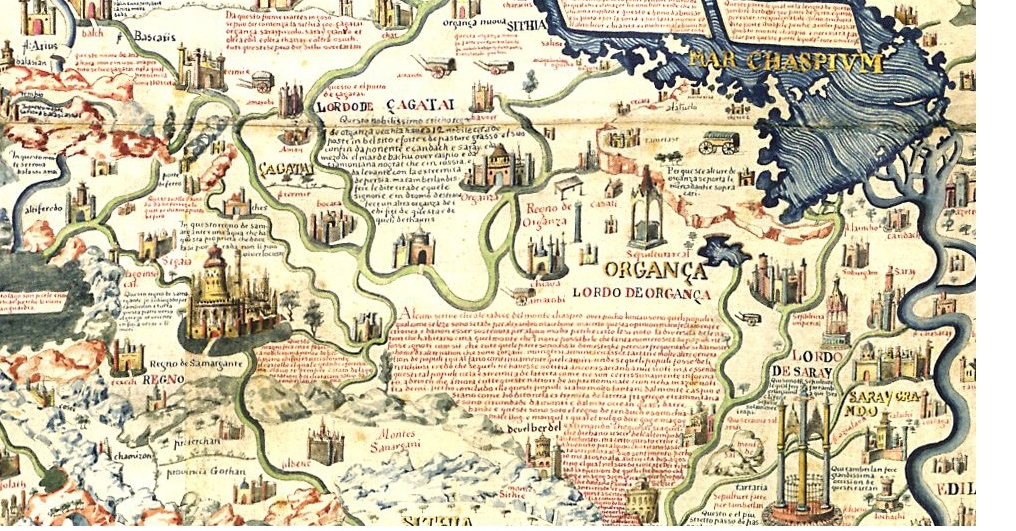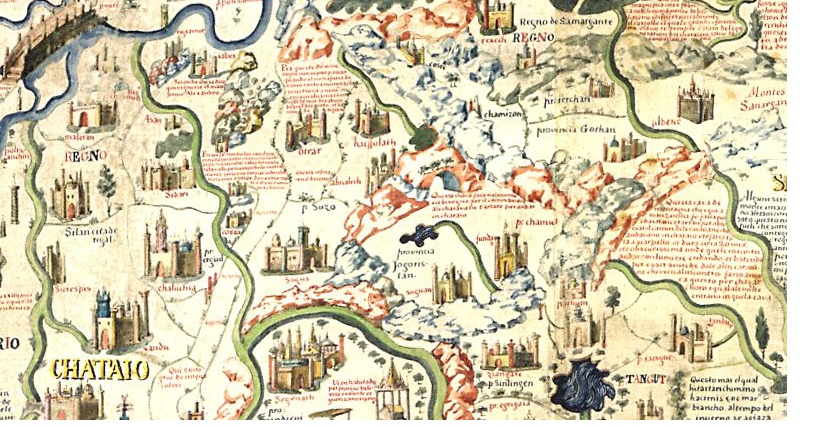The question of undeniable importance for Kazakhstan: to consider the year 1991 as a starting point, or to look for and find the origins of statehood in the shroud of the Middle Ages. Two hundred scientists, historians from Kazakhstan, Russia, Turkey, Ukraine and the United States will exchange their findings and ideas in a series of conferences known as the 550th anniversary of Kazakh Khanate, to be held in Astana in 2015.
[/caption]Among the sources on the history of Kazakh statehood, the medieval maps created in Western Europe have a special place. They reflect not only and not so much the history of Kazakh statehood, as the perception of the place of Kazakh statehood in the global system of political and economic relations in the complex and in many ways intriguing era. In this context, Mappo Mundo, the World Map compiled by Venetian monk Fra Maoro in about 1460, holds a special place as one of the most detailed and large-scale maps of the time. What can it tell us about the history of Kazakhstan’s foreign relations of the era? The answers to this and many other questions are given by the author of the research work, Columbia University professor and director of the Kazakhstan branch of Masters of Development Practice/Global Classroom Rafis Abazov.
Mappo Mundo as a historical source on the history of Kazakh land
The world map of Fra Maoro presents the vision of the world according to the views in the 15th century and depicts among other things the territory of what is now Kazakhstan with some interesting details. The map, commissioned by the King of Portugal, was presumably created between 1450 and 1460 by a Venetian monk-cartographer in the monastery of San Giovanni (near Venice). This is one of the most mysterious and intriguing maps of the Middle Ages, which has haunted researchers from many countries. It is important and interesting because – together with other political and cultural maps of the Middle Ages – it can serve as a source for the study of the history and development of the Kazakh state in the 15th century, particularly in the context of the scientific debate on the 550th anniversary of Kazakh statehood.
This map has its own interesting history as a historical source and it is an important document to study regarding early Kazakh statehood for three reasons. First, it was prepared in consultation with numerous written sources, including many sources that did not survive to the modern era. Second, it was based on numerous personal interviews with travellers and diplomats of the time. Maoro conducted interviews not only with the Venetian and Genoese citizens, but also with traders, travellers and ambassadors who lived in the Asian quarter of Venice. Many of the inhabitants of the Asian quarter were from the Central Asian region, where the foundations of Kazakh statehood were established around the same time. Among them were probably representatives of Kazakh and other Turkic tribes, in particular, Kipchaks. Third, the content of the map is also fascinating, as this monumental map, measuring 2.4 by 2.4 metres, includes about 3,000 written marks, names and notes. Taking into account the characteristics of the era, they may contain special meaning, secret signs and codes including the history of diplomatic and military relations of Venice with states in the territory of Kazakhstan. Third, speaking in the context of Central Asian history, of course, the most valuable part is the usage of written medieval documents. Maoro conducted – in modern terms – a content analysis of information on the political, military and cultural status in the region. Many of these sources have simply not survived to modern time.
Secrets of scientist and cartographer Fra Maoro
We can only guess about the secrets of this monumental research work, as all the scientific and technical archive of cartographer Fra Maoro and all of his records and interviews mysteriously disappeared after his death in 1464 or 1465. What could he have? The answer lies in part in the fate of this map. Even though the map was commissioned and paid by the King of Portugal, Afonso V (1432-1481), researcher Dr. Piero Falchetta suggests that the first copy never reached its customer. He believes that the vaults of Marciano contain the second copy, though it was also made by the author. Falchetta believes that many of the secret lodge spy networks and the royal courts were highly interested that the map would not leave Venice and that its secrets would not reach the destination. Here we must remember that Maoro’s map for some unknown reason is drawn upside down, as if in a mirror. It also reflects the political and cultural perception of the world by the Venetians, or is an attempt to, so that others are not able to decipher its secret meaning.
Here are a few interesting points for studying the history of Kazakhstan. The map could have a lot of secrets and information and shed light on the history of the economic and political relations of Venice and Western Europe with the Kazakh khans. First, it is the history of economic relations and trade on the Silk Road in the second half of the 15th century. It is striking that the Venetians were confident that there was intensive trade in the region and that the great Silk Road continued to exist – this is illustrated by numerous drawing carts on the map. Second, the map can serve as a source for the study of the economic and financial condition of residence in the territory of the Kazakh tribes. It is striking that Maoro and the Venetians did not consider the Kazakh steppe as a desert area and placed a lot of different settlements in its territory (although geographically they are not always reflected in the correct location). Third, the Venetians believed that the Chagatai Dynasty had played a great role in the political organisation of the region in this period – the map contains the individual entries on its political role. That might be an illustration that perhaps Maoro consulted with some individuals from this region. By analogy with the Ottoman and Timurid dynasties and others, we know that the Turkic khans and sultans tried to give their children a good education, including allowing them to travel.
International diplomacy and Kazakh State
This map along with other documents allows us to study the external conditions and prerequisites of the creation of Kazakh statehood and diplomatic relations of the era.
In fact, the theory of state and of government suggests that in order to create a state there should be both internal and external conditions and prerequisites. In this context, we can say that the Mappo Mundo prepared by Maoro in the context of many other materials makes it possible to research about the international background and conditions of the establishment of Kazakh statehood.
The author is a researcher.




